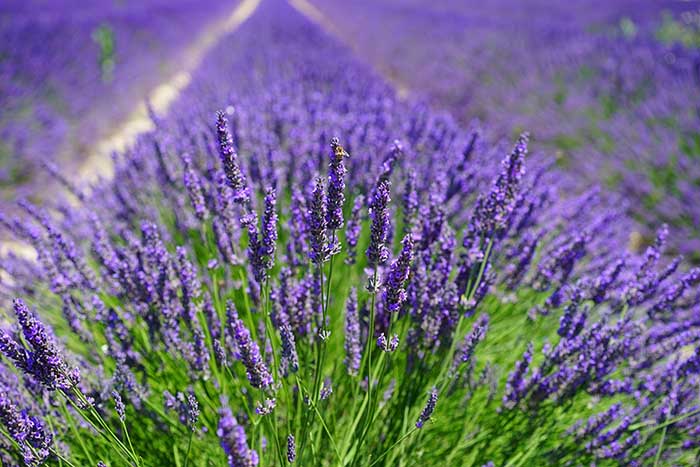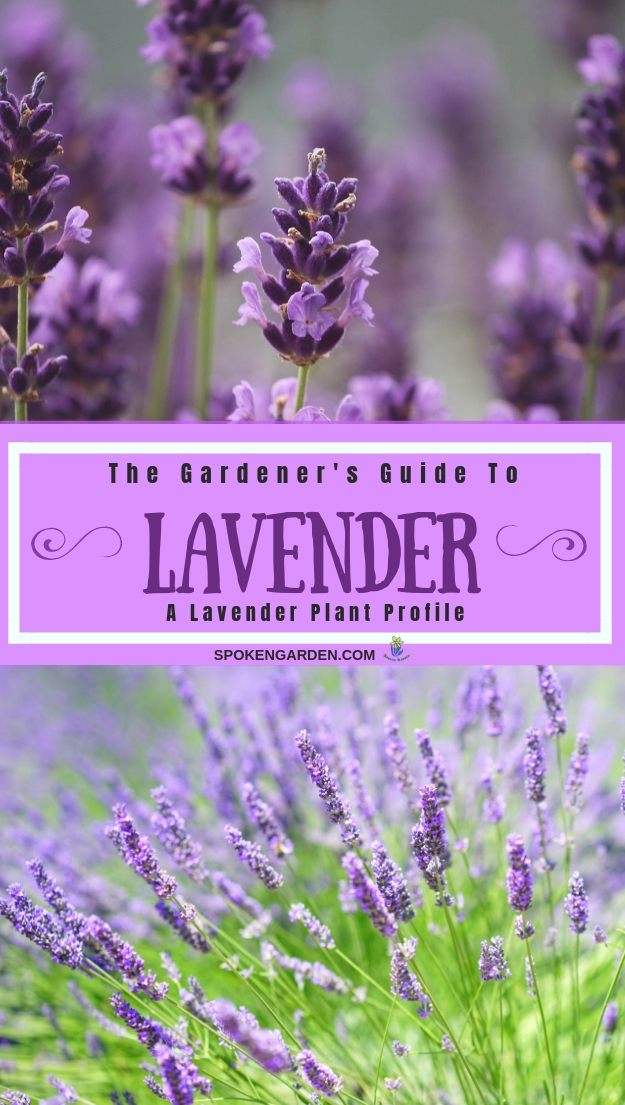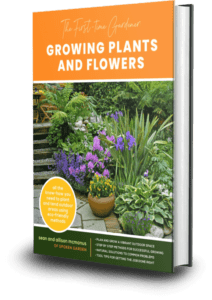Learn all about your beautiful, summer-blooming lavender plants in this gardener’s guide, including plant care, common types, and more.
.

Lavender looks and smells heavenly. From its tall, beautiful, purple flowers to its bushy, green base, lavender steals the hearts of many gardeners the world over. In our Lavender guide below, you’ll learn about the many versatile uses for this amazing plant.
While technically from the Mediterranean, this star of herb gardens around the world doesn’t want for much. It’s as versatile as it is fragrant. And, it requires very little maintenance. Whether your lavender variety is French, English, or Spanish, you can bet that you’ll be fighting off all the pollinators for a chance to use your lavender in some way in the kitchen or elsewhere throughout your home.
Lavender Quick Plant Facts
| Sun Exposure | Full sun |
| Water Needs | Moderate water needed. |
| Soil Needs | Well-draining soil. |
| Cold-Hardiness Zones | USDA hardiness zones - English Lavender grows in zones 5-10; French Lavender grows in zones 5-9; and Spanish Lavender grows in zones 7-9. |
| Bloom Time | Summer to early Fall. |
| Flower Colors | Purple, Blue, sometimes pink (depending on species). |
| Mature Height/Width | Anywhere from inches high to 4-5 feet tall and spreading. Check specific species and cultivars. |
| Plant Spacing | Depends on species' needs. |
Jump ahead to a specific section:
In a hurry? Pin it for later!!
Lavender: Why We’re Featuring This Plant

Save “The Gardener’s Guide to Lavender: Lavender Plant Profile” to Pinterest!
First, who doesn’t want to grow a plant that you can eat, infuse, or use medicinally? This plant is versatile, drought-tolerant, and it is downright beautiful!
Another reason we choose lavender is due to its summer bloom time in our zone 8b. The soft, purple blooms are a welcomed sight in our garden. Plus, pollinators love them!
Finally, we chose lavender because it is so easy to grow and care for. It’s low maintenance needs are perfectly suited for both beginning gardeners and novices alike.
But first, let’s catch up on some history.
Lavender Flowers: Family and History
Lavender Family
Lavender is in the Lamiaceae plant family and the genus Lavandula. This family group, also known as the mint family, includes many other popular herbs like basil, oregano, thyme, rosemary, and many other plants.
In fact, nearly half of your favorite kitchen herbs most likely come from this large family!
Lavender is valued for a range of uses, including:
- Ornamental plants
- Medicinally – for depression, headaches, anxiety, etc.
- Cooking and baking
- Pest control
- Fragrance in soaps, perfumes, etc.
- Aromatherapy
The Lamiaceae family is spread around the world and represents over 3500 species. In North America alone, approximately 50 genera are found.
Lavender History
Lavender has a long, storied history going back to biblical times. The Romans used lavender to scent their baths, beds, clothes and even hair.
They also discovered its medicinal properties. Most likely, the name “lavender” actually came from the Latin ‘lavare’ meaning ‘to wash’. Evidence even suggests that the ancient Egyptians used lavender for mummification over 2500 years ago!
Historically, lavender has been used medicinally and culinarily for thousands of years.
As an herbaceous perennial herb, lavender is used as a perfume, in potpourri, for culinary purposes, for medicinal purposes, and wildly cultivated as an essential oil. Its fragrance has been known to repel pests, soothe skin, and calm raging headaches. The possible uses for lavender are endless.
Symbolically, lavender’s been portrayed as a symbol of love, an object of calmness and serenity, and an object used to ward off evil spirits. In 17th C. England, lavender was thought to protect against the Great Plague and was worn around the wrists of those who could afford it since its prices skyrocketed during this time.
Stories abound regarding lavender’s various uses throughout history. One plant, multiple species, countless uses. Talk about versatility!
The question is, where did lavender first originate?
Most research suggests that lavender originated in the ancient Mediterranean area and possibly the Middle East and India. Used by the Egyptians, Romans, and Greeks, as previously 
Eventually, as with most flower evolution tales, lavender found its way to Europe in the early 1500-1600s (possibly earlier) and the rest is history.
In the early 20th Century, a French scientist discovered the healing properties of lavender essential oil and thus began another boom in lavender’s popularity for use in aromatherapy. Today, this herb is grown and cultivated worldwide.
If you want to read more about the history of lavender, check out Chappell Hill Lavender Farm.
Types of Lavender
According to the US Lavender’s Growers Association, there are 45 different species of lavender with over 450 varieties.
They differ by hardiness zone, colors, uses, and more.
A few examples of types of lavender are:
- English
- French
- Spanish
Read on below to learn a quick breakdown between each lavender type.
1) English Lavender
- Most famous and familiar of all the lavenders
- Native to the Mediterranean
- Grows well in English climates
- Widely diverse
- Purple flowers
- Can tolerate winter moisture and many climates
- Has grayish-green leaves
- Great for culinary uses, like cooking and baking
- Very fragrant
- Varieties include: ‘Hidcote’, ‘Munstead’
2) French Lavender
- Best for landscape plants
- Native to Eastern and Southern Spain
- Not as fragrant as the other lavenders
- Not good for culinary uses
- Purple flowers
- Has grayish-green leaves
- Flowers bloom continuously from summer through fall
3) Spanish Lavender
- Native to the Mediterranean and northern Africa
- Has silvery colored leaves
- Very aromatic foliage
- Dark purple flowers
- Blooms continuously from spring through late summer
- Best for mass plantings, in containers, or as ground covers
Lavender Care
Lavender Plants For Sale
Want to buy your own Lavender plants after learning all about their characteristics? Check out Eden Brother’s great website for amazing herb variety! Eden Brothers’ seeds are non-GMO.
They also have all kinds of other types of plants to choose from.
Right now, Eden Brother’s are offering free shipping on all orders of $79 or more.
Lavender Seeds, Herb Seeds, Eden Brothers
Lavender Seeds. Of all the scores of different lavenders, this one Lavandula angustifolia… [More]
Lavender Plant Conclusion
Due to its versatility, fragrance, and low-maintenance routine, we cannot think of a single reason why you wouldn’t want to plant lavender in your garden.
Perfect for either the beginner or busy gardener, lavender is easy and instantly beneficial. While not asking for much, they are a low-maintenance, beautiful addition to any garden.
Now it is time to hear from you!
How do you plan to use lavender in your garden? What is your favorite type of lavender?
Leave a quick comment below and let us know!
Well, that’s all for now.
Want to learn about other plants in your garden? Check out some of our previous plant profiles:
- The Gardener’s Guide to Sunflowers
- Shasta Daisy: A Gardener’s Guide and Plant Profile
- Crocosmia: A Gardener’s Guide and Plant Profile
- Fuchsia Hanging Basket: A Gardener’s Guide and Plant Profile
- Roses: A Gardener’s Guide and Plant Profile
- Daffodils: A Gardener’s Guide and Plant Profile
See you in the garden!
~ Sean and Allison
P.S. Find us on Pinterest, Twitter, Facebook, and Instagram so you don’t miss a thing!
Lavender Plant References Used:
- “Gardener’s Guide to Lavender” – Better Homes & Gardens
- “Types of Lavender” – HGTV
Spokengarden.com is a participant in the Amazon Services LLC Associates Program, an affiliate advertising program designed to provide a means for sites to earn advertising fees by advertising and linking to Amazon.com



